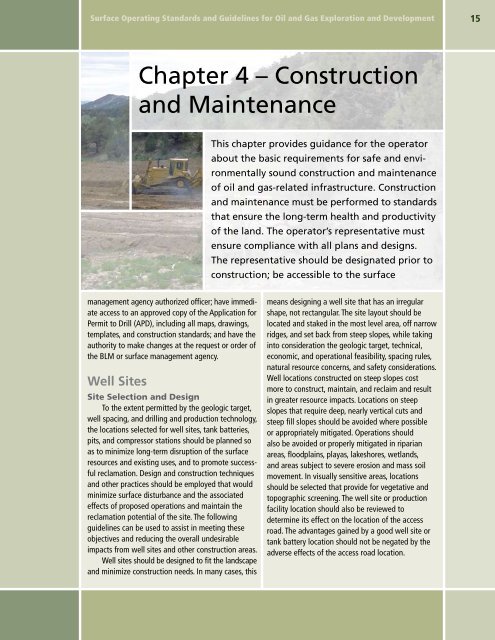Download the Gold Book (pdf 6.3 mb) - Bureau of Land Management
Download the Gold Book (pdf 6.3 mb) - Bureau of Land Management
Download the Gold Book (pdf 6.3 mb) - Bureau of Land Management
You also want an ePaper? Increase the reach of your titles
YUMPU automatically turns print PDFs into web optimized ePapers that Google loves.
Surface Operating Standards and Guidelines for Oil and Gas Exploration and Development<br />
Chapter 4 – Construction<br />
and Maintenance<br />
management agency authorized <strong>of</strong>ficer; have immediate<br />
access to an approved copy <strong>of</strong> <strong>the</strong> Application for<br />
Permit to Drill (APD), including all maps, drawings,<br />
templates, and construction standards; and have <strong>the</strong><br />
authority to make changes at <strong>the</strong> request or order <strong>of</strong><br />
<strong>the</strong> BLM or surface management agency.<br />
Well Sites<br />
Site Selection and Design<br />
To <strong>the</strong> extent permitted by <strong>the</strong> geologic target,<br />
well spacing, and drilling and production technology,<br />
<strong>the</strong> locations selected for well sites, tank batteries,<br />
pits, and compressor stations should be planned so<br />
as to minimize long-term disruption <strong>of</strong> <strong>the</strong> surface<br />
resources and existing uses, and to promote successful<br />
reclamation. Design and construction techniques<br />
and o<strong>the</strong>r practices should be employed that would<br />
minimize surface disturbance and <strong>the</strong> associated<br />
effects <strong>of</strong> proposed operations and maintain <strong>the</strong><br />
reclamation potential <strong>of</strong> <strong>the</strong> site. The following<br />
guidelines can be used to assist in meeting <strong>the</strong>se<br />
objectives and reducing <strong>the</strong> overall undesirable<br />
impacts from well sites and o<strong>the</strong>r construction areas.<br />
Well sites should be designed to fit <strong>the</strong> landscape<br />
and minimize construction needs. In many cases, this<br />
This chapter provides guidance for <strong>the</strong> operator<br />
about <strong>the</strong> basic requirements for safe and envi-<br />
ronmentally sound construction and maintenance<br />
<strong>of</strong> oil and gas-related infrastructure. Construction<br />
and maintenance must be performed to standards<br />
that ensure <strong>the</strong> long-term health and productivity<br />
<strong>of</strong> <strong>the</strong> land. The operator’s representative must<br />
ensure compliance with all plans and designs.<br />
The representative should be designated prior to<br />
construction; be accessible to <strong>the</strong> surface<br />
means designing a well site that has an irregular<br />
shape, not rectangular. The site layout should be<br />
located and staked in <strong>the</strong> most level area, <strong>of</strong>f narrow<br />
ridges, and set back from steep slopes, while taking<br />
into consideration <strong>the</strong> geologic target, technical,<br />
economic, and operational feasibility, spacing rules,<br />
natural resource concerns, and safety considerations.<br />
Well locations constructed on steep slopes cost<br />
more to construct, maintain, and reclaim and result<br />
in greater resource impacts. Locations on steep<br />
slopes that require deep, nearly vertical cuts and<br />
steep fill slopes should be avoided where possible<br />
or appropriately mitigated. Operations should<br />
also be avoided or properly mitigated in riparian<br />
areas, floodplains, playas, lakeshores, wetlands,<br />
and areas subject to severe erosion and mass soil<br />
movement. In visually sensitive areas, locations<br />
should be selected that provide for vegetative and<br />
topographic screening. The well site or production<br />
facility location should also be reviewed to<br />
determine its effect on <strong>the</strong> location <strong>of</strong> <strong>the</strong> access<br />
road. The advantages gained by a good well site or<br />
tank battery location should not be negated by <strong>the</strong><br />
adverse effects <strong>of</strong> <strong>the</strong> access road location.

















